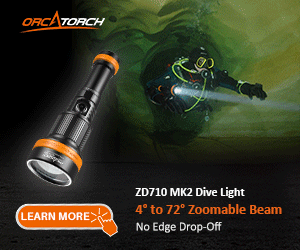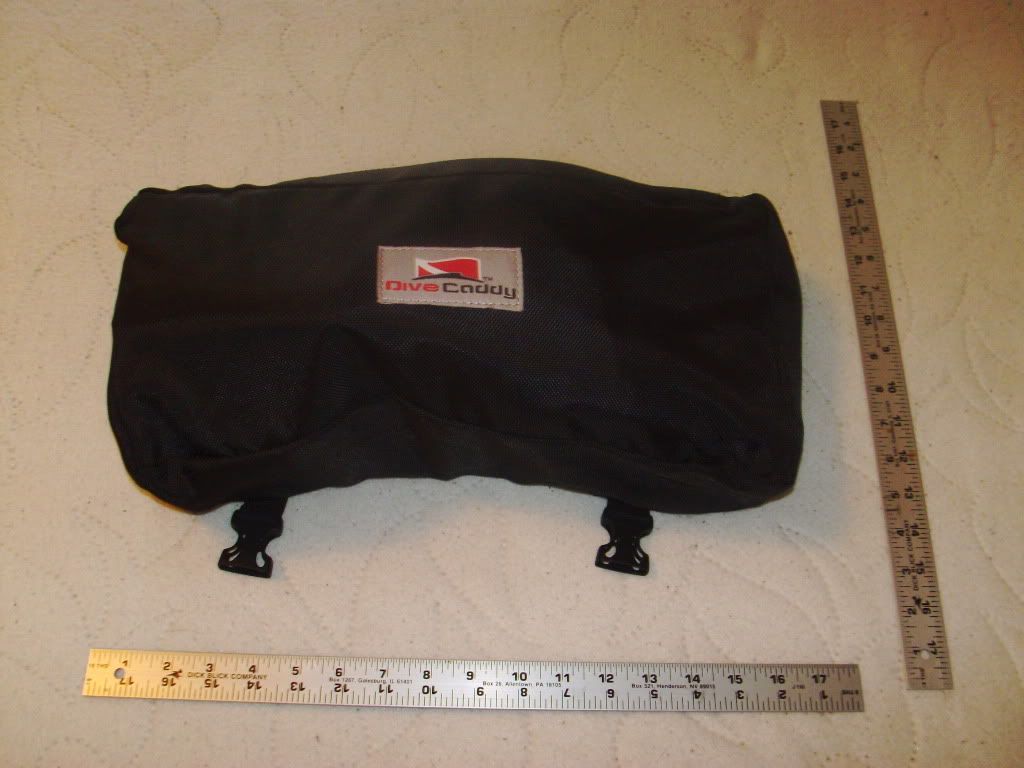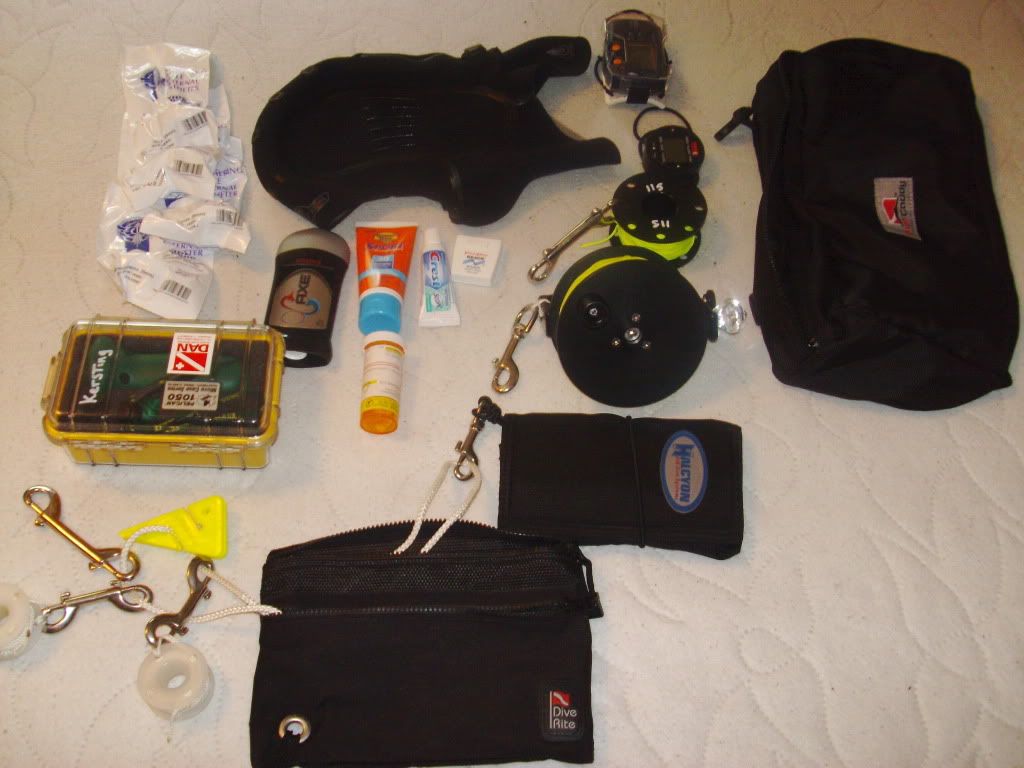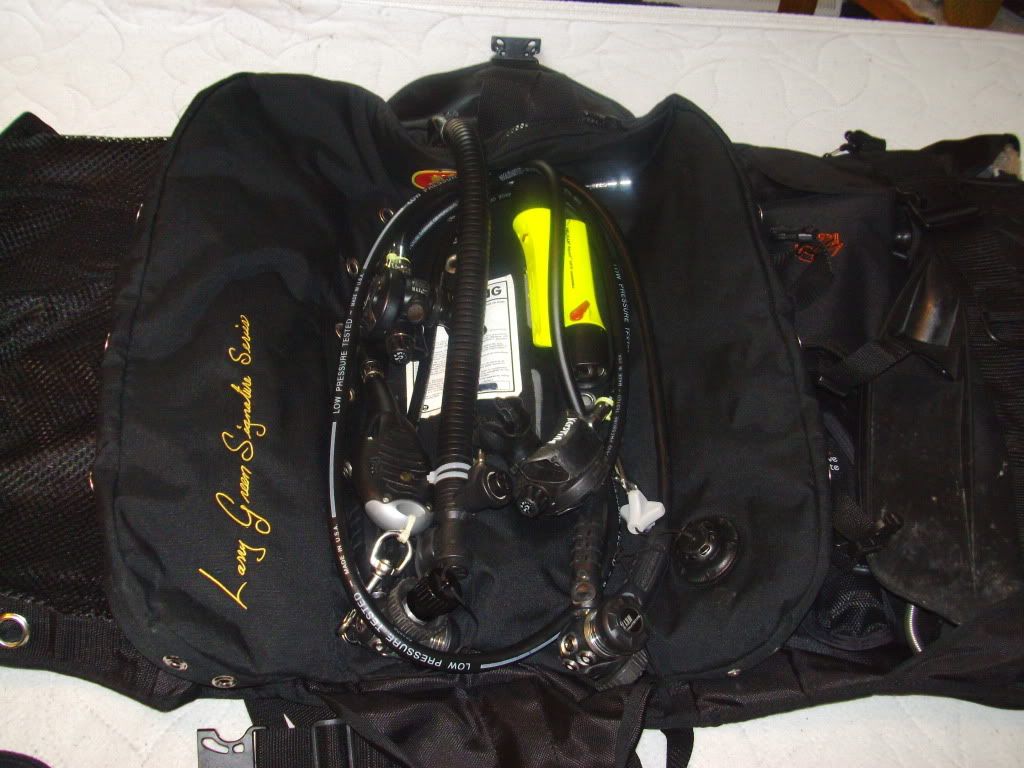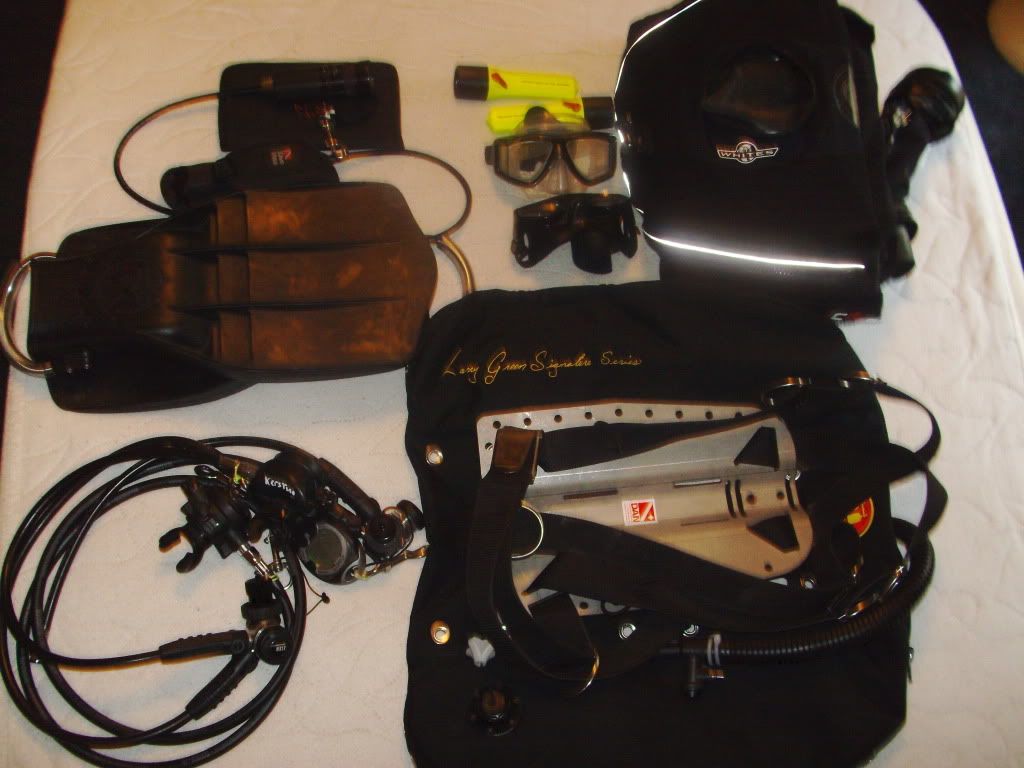NorthWoodsDiver
Contributor
For more info and video go here: Dive Caddy - The Worlds Smartest Dive Bag System!
A few weeks back I noticed this newer product called a Dive Caddy while I was browsing Dive Right In Scuba's website. It seemed like an interesting product but it also appeared to be geared towards the vacation recreational diver. I sent Mike some emails with questions, just out of curiosity cause I cant actually afford to buy the bag, and he sent me a unit to check out in person and return.
So what is "Dive Caddy"? Basically is a modular backpack designed to carry 1 set of standard dive equipment as a carry on while traveling. This includes:
-BCD
-Regulator (single tank)
-Wetsuit, boots, gloves, hood
-Mask, Fins, Snorkel
-Change of cloths, swimsuit
-Travel size toiletries (1 quart TSA approved package)
-and anything else a diver may want to carry on- ie dive lights, smb/reel, etc
I always wanted a way to pack a full set of standard cave kit for travel and still be able to carry it on the plane. Hard sided bags may be sized to fit the maximum dimensions of a carry on compartment but the hard sides don't facilitate packing to get the most gear in that space. Also in a hard sided bag or even a soft side bag things are all stacked on one another so to see whats on the bottom a person must "dig" through the bag which slows up inspections at checkpoints.
So as an example I flew to Mexico last time and I carried on my BP w/o wing, O2 analyzer, 2 bottom timers, doubles regs, stage reg, backup lights, masks, spools, reel, wetnotes, cell phone, GPS, Ipod, etc.
I decided to see how much gear I could cram in this new bag (utilizing as much of the same products as last time and as much new as possible) and post some pictures for you all.
Before I get into pictures I'll break down the components for you. In the box came:
-1 set of instructions (omitted from photos)
-1 Dive Caddy
-1 Turtle Pack
-1 Spider bag
-1 fin Caddy
The instructions were not really instructions but more of a photo description of each component and what could be placed inside it. However the instruction book does include information about the materials used and the overall maximum dimensions.
I weighed the entire system and it came out at about 5.4lbs which is lighter than any other bag I have used to travel with. It appears to be very durable and extremely well constructed. A lot of time went into its design from what I can tell.
Dimensionally its difficult to measure this bag but it works out to be about 18X30 inches and the thickness is highly dependent on what you pack in it. However by removing the turtle pack from the top you can immediately remove about 6 inches from the length of the bag in case your airline has tighter size restrictions.
When you first open things up it's a mess of "Fastex" style (side release) buckles and straps but once you break things down its pretty simple to figure out what goes where. One feature I can really appreciate is that each strap has a bungee ring on it to secure the tail section of each strap. If you cinch down a strap you always get a section of the tail end of the strap which dangles around, that loop prevents this from happening. Though for the photos I didn't mess with adjusting everything and hiding all the straps.
I managed to cram enough gear in the bag to bring the total weight to 55.6lbs which if you are familiar with travel restrictions is about 16lbs overweight for carry on. I have never had my carry on weighted though and if you look at what I have listed its probably not standard travel gear (ie 9lb stainless backplate).
If you go to www.divecaddy.net there are videos and photos with descriptions also. In one of the videos they suggest you just carry your pack like it's a normal light weight bag which I assume is to allude security to the fact that your bag is over weight. Again the idea with this is that you can carry on all your essential gear within the size limits not necessarily within weight limits.
So I will break down everything I packed in this time.
In the main section of the bag it's segmented into 3 panels which fold over one another. The left panel is designed to hold a wetsuit, boots, gloves, and hood while the center panel holds the bcd and the right panel holds the "Fin Caddy containing regulator, fins, mask, and snorkel.
My twist to this portion is:
Left panel- Fusion Drysuit w/ tech skin, pockets, & p-valve.
Center Panel- 9lb SS plate, hog harness, 45lb OMS Larry Green wing, double tank regs (2 mk17, 2 S600, DS/BC inflator, pressure gauge), and 2 backup lights w/ batteries.
*I didn't have a spare pressure gauge around as they are on my sidemount regs so I substituted my suunto cobra
Right Panel- Turtle Fins, mask, backup mask, and DR LED 500 light w/ batteries.
*Note that I didn't use the Fin Caddy, though its compact enough that it would fit just fine.
The small bag on the top is called the "Turtle pack" and is designed to hold items which you would like easier access to or items which are odd shaped and don't fit elsewhere. The instructions don't provide examples of items to store here but the website has several ideas.
I placed some common travel and cave diver items in mine:
-1 Quart ziplock bag with some 3oz goodies inside and some medications (which I don't take but they were around for pictures)
-Hood, cause I forgot to put it in with the suit
-4 Wideband condom catheters
-400' Salvo primary reel
-115' safety spool
-Bottom timer and wrist computer
-O2 analyzer
-Dive Rite 2 zipper pocket containing 2 mini spools, wetnotes, arrows, and double ender.
The Turtle Pack wasn't full I just ran out of convenient items to place inside. An Ipod, GPS, and Phone would have fit easily.
The 3rd component is the "Spider Bag" and its basically designed to carry a change of cloths, beach shoes, and other items. I would have used my undergarments and a change of cloths but my undergarments were wet so I did this:
-3 pairs of socks
-3 pairs of boxer style underwear
-3 pairs of shorts, 1 is swimming trunks
-3 shirts
-1 pair of shoes
The shoes made things look bulky but I could have added a couple other changes of cloths or a thin jacket to this bag also. If I was traveling though it would most likely be my undergarments and ds boots in this portion and that would fit fine.
I omitted some items because they were wet or not around like my drysuit boots and dry gloves. I also didn't add a stage regulator or O2 reg but I could have. IN real life I probably wouldn't leave batteries in my lights to conserve weight and I would probably have used a lighter plate too. If your diving sidemount then you could have added even more gear and still been within weight limits probably.
Because the bag utilizes layering and compression you can fit a large volume of equipment in a fairly small area. Because of the layering all of my fragile items like regs and lights were protected by the plate and wing on one side and by clothing and drysuit and fins on the other sides.
This layering also makes the bag easy to display to security officials at checkpoints without them having to rummage through everything. If you should want to access something on the interior it's a simple process to open virtually any part of the bag up to remove any item you wish.
There are a few items I have not mentioned like a water bottle holder on the side and some misc pockets for storing small items like a passport or dive certs.
So after inspecting the bag in person I would have to say it would serve the average double tank diver pretty well. Your not going to bring everything for an expedition in this pack and your not going to cram all your cloths and dive gear in here for a 3 week vacation but for the purpose of carrying most of your standard tech gear it's probably going to handle more equipment then any other bag yet still fit within the airline restrictions.
Full of gear rear profile:
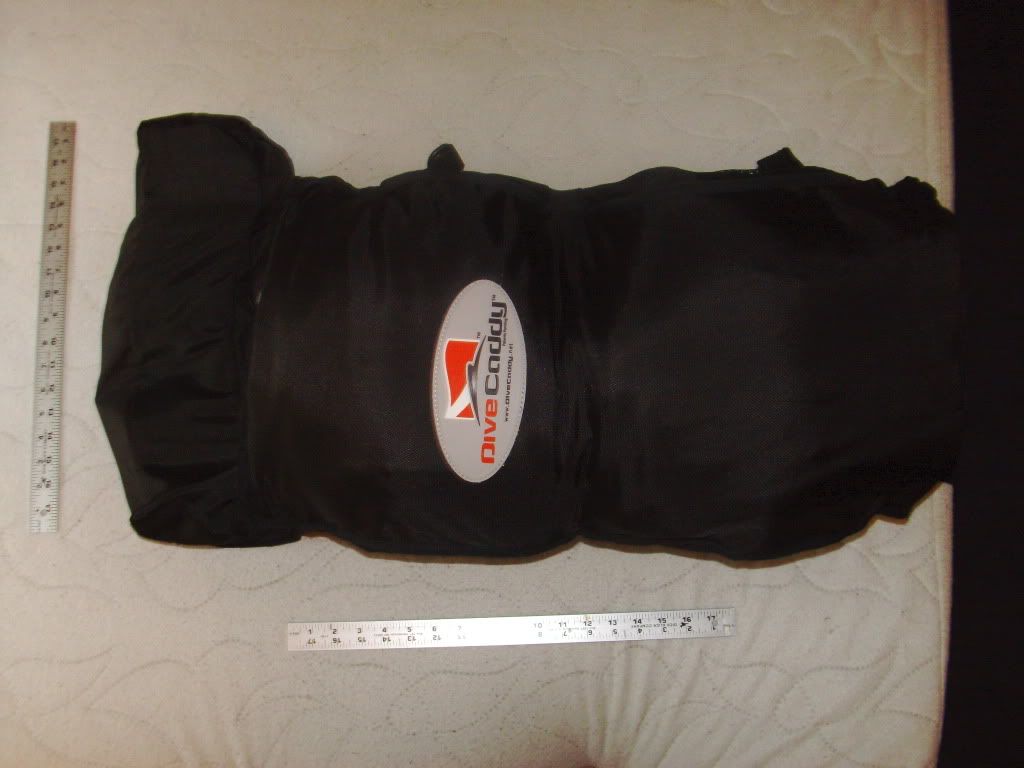
Full of gear side profile:
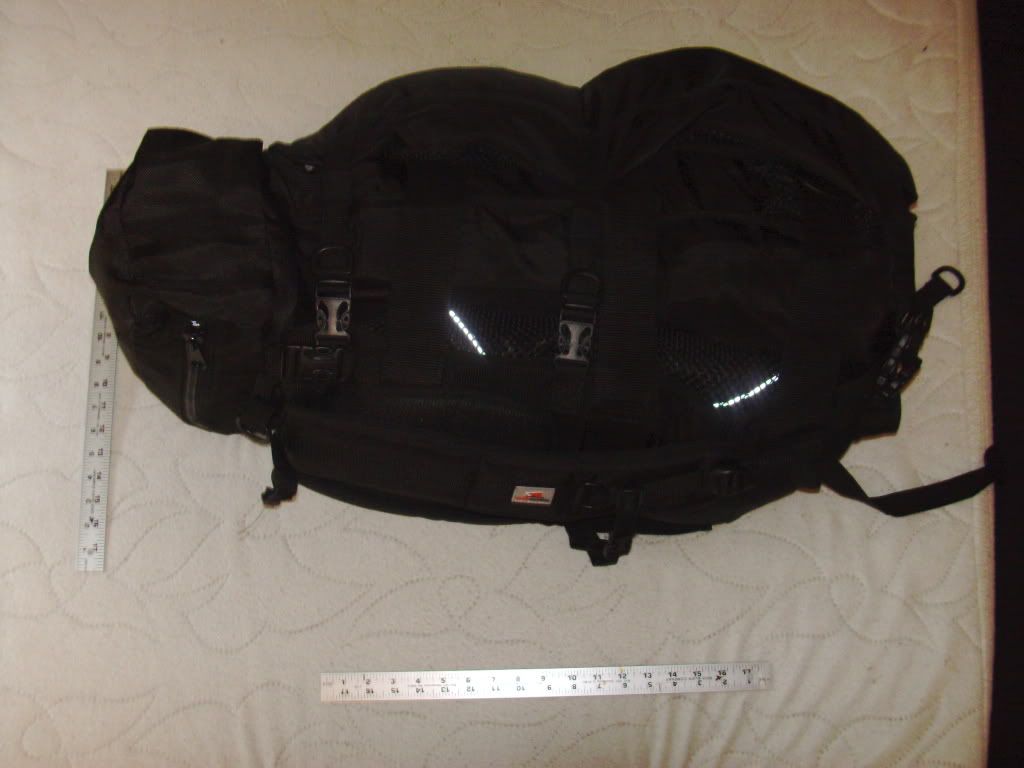
Everything that was in the Spider Bag:
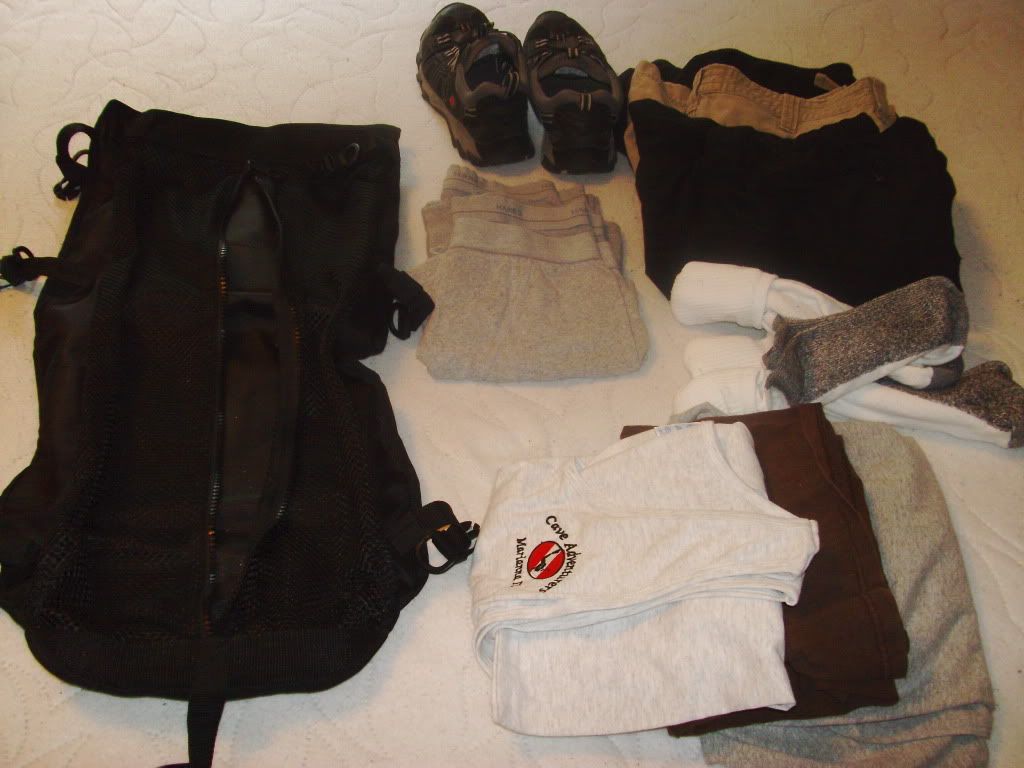
A few weeks back I noticed this newer product called a Dive Caddy while I was browsing Dive Right In Scuba's website. It seemed like an interesting product but it also appeared to be geared towards the vacation recreational diver. I sent Mike some emails with questions, just out of curiosity cause I cant actually afford to buy the bag, and he sent me a unit to check out in person and return.
So what is "Dive Caddy"? Basically is a modular backpack designed to carry 1 set of standard dive equipment as a carry on while traveling. This includes:
-BCD
-Regulator (single tank)
-Wetsuit, boots, gloves, hood
-Mask, Fins, Snorkel
-Change of cloths, swimsuit
-Travel size toiletries (1 quart TSA approved package)
-and anything else a diver may want to carry on- ie dive lights, smb/reel, etc
I always wanted a way to pack a full set of standard cave kit for travel and still be able to carry it on the plane. Hard sided bags may be sized to fit the maximum dimensions of a carry on compartment but the hard sides don't facilitate packing to get the most gear in that space. Also in a hard sided bag or even a soft side bag things are all stacked on one another so to see whats on the bottom a person must "dig" through the bag which slows up inspections at checkpoints.
So as an example I flew to Mexico last time and I carried on my BP w/o wing, O2 analyzer, 2 bottom timers, doubles regs, stage reg, backup lights, masks, spools, reel, wetnotes, cell phone, GPS, Ipod, etc.
I decided to see how much gear I could cram in this new bag (utilizing as much of the same products as last time and as much new as possible) and post some pictures for you all.
Before I get into pictures I'll break down the components for you. In the box came:
-1 set of instructions (omitted from photos)
-1 Dive Caddy
-1 Turtle Pack
-1 Spider bag
-1 fin Caddy
The instructions were not really instructions but more of a photo description of each component and what could be placed inside it. However the instruction book does include information about the materials used and the overall maximum dimensions.
I weighed the entire system and it came out at about 5.4lbs which is lighter than any other bag I have used to travel with. It appears to be very durable and extremely well constructed. A lot of time went into its design from what I can tell.
Dimensionally its difficult to measure this bag but it works out to be about 18X30 inches and the thickness is highly dependent on what you pack in it. However by removing the turtle pack from the top you can immediately remove about 6 inches from the length of the bag in case your airline has tighter size restrictions.
When you first open things up it's a mess of "Fastex" style (side release) buckles and straps but once you break things down its pretty simple to figure out what goes where. One feature I can really appreciate is that each strap has a bungee ring on it to secure the tail section of each strap. If you cinch down a strap you always get a section of the tail end of the strap which dangles around, that loop prevents this from happening. Though for the photos I didn't mess with adjusting everything and hiding all the straps.
I managed to cram enough gear in the bag to bring the total weight to 55.6lbs which if you are familiar with travel restrictions is about 16lbs overweight for carry on. I have never had my carry on weighted though and if you look at what I have listed its probably not standard travel gear (ie 9lb stainless backplate).
If you go to www.divecaddy.net there are videos and photos with descriptions also. In one of the videos they suggest you just carry your pack like it's a normal light weight bag which I assume is to allude security to the fact that your bag is over weight. Again the idea with this is that you can carry on all your essential gear within the size limits not necessarily within weight limits.
So I will break down everything I packed in this time.
In the main section of the bag it's segmented into 3 panels which fold over one another. The left panel is designed to hold a wetsuit, boots, gloves, and hood while the center panel holds the bcd and the right panel holds the "Fin Caddy containing regulator, fins, mask, and snorkel.
My twist to this portion is:
Left panel- Fusion Drysuit w/ tech skin, pockets, & p-valve.
Center Panel- 9lb SS plate, hog harness, 45lb OMS Larry Green wing, double tank regs (2 mk17, 2 S600, DS/BC inflator, pressure gauge), and 2 backup lights w/ batteries.
*I didn't have a spare pressure gauge around as they are on my sidemount regs so I substituted my suunto cobra
Right Panel- Turtle Fins, mask, backup mask, and DR LED 500 light w/ batteries.
*Note that I didn't use the Fin Caddy, though its compact enough that it would fit just fine.
The small bag on the top is called the "Turtle pack" and is designed to hold items which you would like easier access to or items which are odd shaped and don't fit elsewhere. The instructions don't provide examples of items to store here but the website has several ideas.
I placed some common travel and cave diver items in mine:
-1 Quart ziplock bag with some 3oz goodies inside and some medications (which I don't take but they were around for pictures)
-Hood, cause I forgot to put it in with the suit
-4 Wideband condom catheters
-400' Salvo primary reel
-115' safety spool
-Bottom timer and wrist computer
-O2 analyzer
-Dive Rite 2 zipper pocket containing 2 mini spools, wetnotes, arrows, and double ender.
The Turtle Pack wasn't full I just ran out of convenient items to place inside. An Ipod, GPS, and Phone would have fit easily.
The 3rd component is the "Spider Bag" and its basically designed to carry a change of cloths, beach shoes, and other items. I would have used my undergarments and a change of cloths but my undergarments were wet so I did this:
-3 pairs of socks
-3 pairs of boxer style underwear
-3 pairs of shorts, 1 is swimming trunks
-3 shirts
-1 pair of shoes
The shoes made things look bulky but I could have added a couple other changes of cloths or a thin jacket to this bag also. If I was traveling though it would most likely be my undergarments and ds boots in this portion and that would fit fine.
I omitted some items because they were wet or not around like my drysuit boots and dry gloves. I also didn't add a stage regulator or O2 reg but I could have. IN real life I probably wouldn't leave batteries in my lights to conserve weight and I would probably have used a lighter plate too. If your diving sidemount then you could have added even more gear and still been within weight limits probably.
Because the bag utilizes layering and compression you can fit a large volume of equipment in a fairly small area. Because of the layering all of my fragile items like regs and lights were protected by the plate and wing on one side and by clothing and drysuit and fins on the other sides.
This layering also makes the bag easy to display to security officials at checkpoints without them having to rummage through everything. If you should want to access something on the interior it's a simple process to open virtually any part of the bag up to remove any item you wish.
There are a few items I have not mentioned like a water bottle holder on the side and some misc pockets for storing small items like a passport or dive certs.
So after inspecting the bag in person I would have to say it would serve the average double tank diver pretty well. Your not going to bring everything for an expedition in this pack and your not going to cram all your cloths and dive gear in here for a 3 week vacation but for the purpose of carrying most of your standard tech gear it's probably going to handle more equipment then any other bag yet still fit within the airline restrictions.
Full of gear rear profile:

Full of gear side profile:

Everything that was in the Spider Bag:



